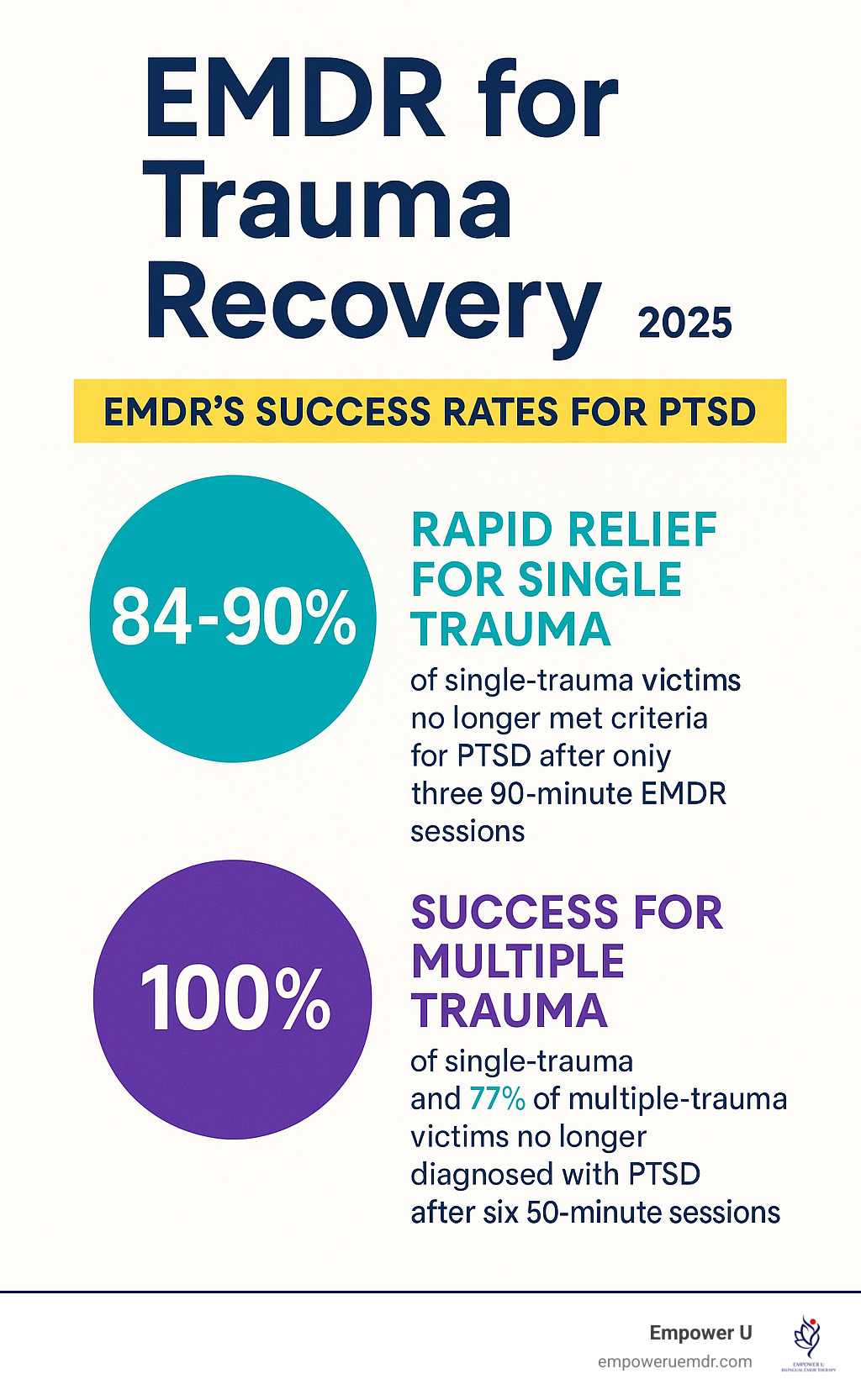EMDR Therapy for Trauma Recovery: Healing Through Culturally Responsive Care

Understanding EMDR Therapy for Trauma Recovery in a Cultural Context
EMDR therapy offers a transformative path to healing for those carrying the weight of unprocessed traumatic experiences. As someone who understands the unique challenges faced by adult children of immigrants and those who came to this country at a young age, I've witnessed how trauma isn't always a single dramatic event. For many in my community, trauma manifests as the accumulated stress of navigating between two worlds—the persistent anxiety of never quite belonging, the guilt of wanting something different from what your parents sacrificed for, and the exhausting responsibility of being a cultural bridge for your family.
Eye Movement Desensitization and Reprocessing (EMDR) therapy is an evidence-based approach that helps your brain reprocess these "stuck" traumatic memories and distressing life experiences. Unlike traditional talk therapy, EMDR therapy doesn't require you to relive traumatic events in exhaustive detail. Instead, this movement desensitization and reprocessing approach activates your brain's natural healing process through bilateral stimulation—gentle eye movements, sounds, or taps—while you briefly focus on upsetting memories. This unique form of EMDR therapy helps reduce negative emotions and transforms negative beliefs into empowering ones.
As a bilingual therapist who switched from engineering to therapy as part of my own journey of reconnecting with myself, I understand what it's like to question who you are and where you belong. At Empower U in Irvine, CA, I create a culturally sensitive space where your story is honored within the context of your heritage, family dynamics, and the complex experience of living between cultures.
What Makes EMDR Therapy Different: The Science Behind Healing
EMDR therapy operates on the adaptive information processing model, which recognizes that traumatic experiences can become neurologically "stuck" in isolated networks in your brain. When traumatic memories remain unprocessed, everyday triggers—a tone of voice, a smell, or even a look—can make you feel like you're experiencing the original trauma all over again, complete with the same intense negative emotions and limiting negative beliefs about yourself.
During EMDR therapy sessions, bilateral stimulation through eye movements appears to mimic the brain activity that occurs during REM sleep, when we naturally process experiences. This eye movement desensitization process helps your brain access trapped traumatic memories and connect them with more adaptive information that already exists in your mind. The result is profound: painful negative beliefs like "I'm not good enough" or "I don't belong anywhere" can transform into empowering positive beliefs like "I am worthy of love" or "I can honor both my heritage and my authentic self."
The effectiveness of EMDR therapy is backed by over 30 controlled studies focusing on treating trauma and post traumatic stress disorder. Research shows that this effective treatment helps 84-90% of single trauma victims no longer meet criteria for posttraumatic stress disorder after just three sessions, while 77% of multiple trauma victims find successful treatment results in fewer sessions compared to other therapies. The World Health Organization, American Psychiatric Association, and U.S. Department of Veterans Affairs all recommend EMDR therapy as a first-line trauma treatment for psychological trauma.

Who Benefits from EMDR Therapy: Beyond Traditional Trauma Treatment
While EMDR therapy is renowned for treating post traumatic stress disorder, its healing potential extends to the complex, often invisible wounds that many bicultural individuals carry. In my EMDR practice, I work with clients navigating various mental health challenges including:
Cultural Identity Conflicts: The exhausting mental gymnastics of code-switching between different versions of yourself, leading to identity confusion and a deep sense of not belonging anywhere.
Intergenerational Traumatic Stress: The crushing weight of family expectations, guilt over surpassing your parents' achievements, or anxiety about not fulfilling your role as the family's bridge to American culture.
Chronic Anxiety and Depression: Often rooted in past traumatic experiences where you learned the world wasn't safe for someone like you, or from the accumulated traumatic stress of living between competing cultural values.
Self-Doubt and Shame: Adaptive responses to the impossible double-binds of bicultural life, such as shame about not fitting cultural molds or deep self-doubt from inconsistent expectations that create persistent negative thoughts.
Somatic Complaints: Unexplained physical sensations like chronic pain, headaches, digestive issues, or persistent tension that may be your body's way of holding unprocessed traumatic stress and uncomfortable physical sensations.
The Cultural Dimension: Understanding EMDR Therapy for Diverse Communities
Working with immigrants from collectivistic cultures—including Latino, Asian, Middle Eastern, North African, Russian, and other backgrounds—requires understanding how traumatic experiences intersect with cultural values. In collectivistic cultures, individual desires often conflict with family honor, intergenerational responsibility, and maintaining cultural identity.
I understand these dynamics personally. As a bicultural individual in a biracial, bicultural marriage raising three American children, I've navigated the challenges of honoring family traditions while carving out my own path. This lived experience helps me create a space where you don't have to choose between your heritage and your authentic self.
My EMDR therapy approach recognizes that healing happens not in isolation but within the context of your relationships, cultural background, and generational influences. I offer bilingual EMDR therapy in English and Spanish and understand the unique challenges faced by immigrants from collectivistic cultures, ensuring that nothing gets lost in translation—literally or figuratively.
The Eight-Phase EMDR Protocol: Your Personalized Healing Journey
EMDR therapy follows a structured eight-phase treatment protocol that I customize to your unique needs, cultural background, and healing pace. This comprehensive EMDR treatment approach ensures your safety and comfort guide every step of our collaborative process.
Phases 1-2: Building Your Foundation Through EMDR Therapy
History-Taking and Treatment Planning: I listen deeply to understand your story, current distress, strengths, and cultural context. We explore how your traumatic experiences fit within your family dynamics, cultural background, and life transitions. I often use a timeline to map key events, helping us both see patterns and turning points that shaped your sense of self. This phase involves careful treatment planning to identify targeted memory networks for our EMDR therapy work.
Preparation: Before approaching any difficult traumatic memories, we build a robust set of coping resources. This includes techniques like the "Safe Place" visualization and "Container" exercise to help you manage distressing material between EMDR therapy sessions. Drawing from Internal Family Systems (IFS) principles, we also identify and befriend the protective parts of you that have worked so hard to keep you safe from further traumatic experiences.
Phases 3-6: The Core EMDR Processing Work
Assessment: We identify a specific targeted memory or traumatic experience to process, noting the associated image, negative belief, bodily sensations, and level of affective distress.
Desensitization Through Eye Movement: While holding the targeted memory in mind, I guide you through sets of bilateral stimulation using eye movements or other forms of bilateral stimulation. You simply notice what comes up—thoughts, feelings, or physical sensations—without having to verbalize everything. This is where your brain begins making new connections through EMDR processing and the emotional charge of traumatic memories starts to decrease.
Installation of Positive Beliefs: We strengthen positive beliefs until they feel genuinely true. For example, "I am powerless" might transform into "I have choices now" or "I can honor both my heritage and my dreams."
Body Scan: We check for any remaining physical sensations or uncomfortable physical sensations connected to the memory and process them until your body feels calm and clear.
Phases 7-8: Integration and Lasting Change Through EMDR Therapy
Closure: Every EMDR therapy session ends with grounding techniques to ensure you leave feeling stable and centered.
Re-evaluation: At the beginning of subsequent EMDR therapy sessions, we check that previous work has held and identify what traumatic memories to address next, ensuring the healing integrates into your daily life.

What to Expect: Your EMDR Therapy Journey
The First Session: Beginning Your Story
In our initial 50-minute session, I invite you to share your story at your own pace. We'll discuss what brings you to EMDR therapy, the patterns you've noticed, and your hopes for healing. I listen without judgment, asking gentle questions to help you reflect on the context of your traumatic experiences—your family dynamics, cultural background, identity, or life transitions.
We're not looking for what's "wrong" with you. Instead, we're seeking meaning, connections, and ways to reclaim your voice and power within the framework of your cultural reality through this natural healing process.
Once We Begin EMDR Therapy: A Collaborative Approach
Understanding Your Story in Context: We explore your traumatic experiences through the lens of your cultural background, family dynamics, generational influences, and current life stage. This contextual understanding is crucial for meaningful mental health recovery.
Clarity, Education, and Planning: I provide psychoeducation about what may be happening emotionally and neurologically during EMDR processing, helping you gain perspective and feel more empowered. We develop a collaborative treatment planning approach tailored to your specific needs.
Building Daily Life Resources: Before deep EMDR processing work, we focus on creating safety and stability through DBT skills for emotional regulation, anxiety reduction strategies, and grounding techniques to manage stressful events.
Understanding Your Internal System: Using IFS-informed work, we compassionately explore different parts of you—those protective inner voices that developed to help you survive traumatic events but may now cause pain or keep you stuck.
Healing at the Root Through EMDR Therapy: Once you feel safe and resourced, we use eye movement desensitization and reprocessing to target and reprocess the root causes—often early traumatic memories or experiences that shaped painful negative beliefs about yourself, your worth, and your place in the world.
Rebuilding from Within: We integrate practices that help you live with greater purpose and awareness, build self-respect and self-trust, and assert your needs and values in daily life.
The Unique Benefits of Online EMDR Therapy
Research confirms that online EMDR therapy is as effective as in-person sessions for treating trauma. Virtual EMDR therapy offers unique advantages, especially for bicultural individuals: you can heal from the comfort and privacy of your own space, with greater flexibility for your schedule. Processing difficult family or cultural dynamics from home through EMDR therapy sessions can feel particularly empowering.
All you need is a private space and stable internet connection to begin your EMDR therapy journey, regardless of where you are in California.
Beyond PTSD: Comprehensive Mental Health Healing Through EMDR Therapy
While EMDR therapy is highly effective for posttraumatic stress disorder and reducing PTSD symptoms, its benefits extend far beyond trauma symptoms. Clients often experience:
- Reduced anxiety and depression, including relief from anxiety disorders
- Improved sleep quality and stress management
- Relief from chronic pain and somatic complaints
- Greater emotional regulation and resilience
- Enhanced self-esteem and confidence
- Improved relationships and communication
- A stronger sense of cultural identity and belonging
The goal of EMDR therapy isn't just symptom reduction—it's empowerment to live as your full, authentic self while honoring your heritage and values through this effective treatment approach.
Integrating Multiple Approaches for Holistic Mental Health Care
My EMDR therapy approach combines eye movement desensitization and reprocessing with other evidence-based modalities to provide comprehensive mental health care:
Cognitive Behavioral Therapy (CBT): Helps identify and change unhelpful thought patterns and negative thoughts that may be culturally influenced.
Dialectical Behavior Therapy (DBT): Provides practical skills for emotional regulation, distress tolerance, and interpersonal effectiveness when dealing with traumatic stress.
Internal Family Systems (IFS): Helps you understand and integrate different parts of yourself with compassion following traumatic experiences.
Narrative Therapy: Empowers you to rewrite your story, separating your identity from your problems and recognizing your agency in shaping your future.
This integrative approach ensures that healing through EMDR therapy addresses not just symptoms but the whole person within their cultural context.
When to Consider EMDR Therapy for Trauma Recovery
You might benefit from EMDR therapy if you:
- Feel stuck in patterns of anxiety, self-doubt, or depression
- Experience guilt about wanting a life different from family expectations
- Struggle with identity conflicts between your heritage and mainstream culture
- Have unexplained physical sensations that doctors can't fully address
- Feel hypervigilant or on edge much of the time
- Experience intrusive thoughts or upsetting memories
- Avoid certain situations or places due to past disturbing events
- Feel disconnected from your authentic self due to traumatic stress
Remember, you don't need a formal posttraumatic stress disorder diagnosis to benefit from EMDR therapy. Many of my clients find profound relief from the accumulated stress of navigating between cultures through this structured therapy approach, even when their experiences wouldn't traditionally be labeled as "traumatic."
Finding the Right EMDR Therapist for Your Healing Journey
Choosing the right EMDR therapist is crucial for successful treatment outcomes. When searching for EMDR therapists, it's important to look for someone who is trained in the complete eye movement desensitization and reprocessing protocol and understands the cultural complexities you face.
An experienced EMDR therapist will be well-versed in the structured therapy approach, including the use of eye movements and other forms of bilateral stimulation to help you process traumatic memories safely and effectively. Don't hesitate to ask about their training, experience with treating trauma, and how they tailor EMDR therapy sessions to meet the unique needs of each client.
Equally important is finding an EMDR therapist who creates a compassionate, non-judgmental space where you feel truly seen and heard. Healing from traumatic stress often involves sharing vulnerable parts of your story, so it's essential that your therapist respects your pace and cultural background.
Frequently Asked Questions About EMDR Therapy
How long does EMDR therapy take?0-20 The length varies for each person. Simple, single-incident traumatic experiences may resolve in fewer sessions (6-12), while complex cultural and intergenerational traumatic stress typically requires more EMDR therapy sessions (25 -100). I prioritize thoroughness over speed, ensuring we build a strong foundation of safety first through our eight-phase approach.
Do I have to describe my traumatic memories in detail? No. EMDR therapy allows for healing without extensive verbal disclosure about traumatic events. Your work during EMDR processing is primarily internal—simply noticing what arises during bilateral stimulation. This approach feels safer for many people, especially those from cultures where certain topics aren't openly discussed.
What if I don't speak perfect English? I offer bilingual EMDR therapy in Spanish and understand that some traumatic experiences are better expressed in your first language. We can work in whatever language feels most natural for different aspects of your healing through movement desensitization and reprocessing.
Is EMDR therapy safe? EMDR therapy is very safe when conducted by a trained therapist using the proper eye movement desensitization protocol. You might experience temporary increases in dreams or emotions between sessions as your brain continues EMDR processing, but this typically subsides as traumatic memories are fully resolved.
How does EMDR therapy compare to other therapies? Research shows EMDR therapy often achieves results in fewer sessions compared to other therapies, particularly for treating trauma and posttraumatic stress disorder. The adaptive information processing model underlying EMDR therapy makes it uniquely effective for processing traumatic memories and transforming negative beliefs.
The Research Behind EMDR Therapy's Effectiveness
The effectiveness of EMDR therapy for treating trauma is supported by extensive research. Studies consistently show that this eye movement desensitization approach provides rapid relief from traumatic stress symptoms. The World Health Organization and American Psychiatric Association recognize EMDR therapy as an effective treatment for post traumatic stress disorder, while the Department of Veterans Affairs recommends it for military personnel experiencing traumatic stress.
Research demonstrates that EMDR therapy's unique combination of bilateral stimulation and focused attention on traumatic memories creates lasting changes in how the brain processes disturbing events. This natural healing process allows people to heal from traumatic experiences without the extended timelines often required by other therapies.

Taking the First Step Toward Healing Through EMDR Therapy
EMDR therapy offers a path to reclaim your story and live authentically while honoring your heritage. As someone who has navigated my own bicultural journey, I understand the unique challenges you face when dealing with traumatic stress and cultural identity conflicts. I don't see people as broken—I help them make sense of their struggles by looking at the bigger picture of their lives through compassionate EMDR therapy.
My goal through EMDR therapy is to help you feel more at peace, more confident, and empowered to live as your full, authentic self. In my EMDR practice in Irvine, CA, I create a space where your cultural background is not just acknowledged but celebrated as a source of strength and wisdom.
If you're ready to begin your journey toward healing through EMDR therapy, I invite you to take the first step. Contact me to learn more about how eye movement desensitization and reprocessing can help you heal from traumatic experiences while building a future that honors both your heritage and your dreams.
Healing through EMDR therapy is possible, and you don't have to navigate this journey alone. Together, we can help you find your way back to yourself through this powerful, evidence-based approach to treating trauma and supporting your mental health recovery.



